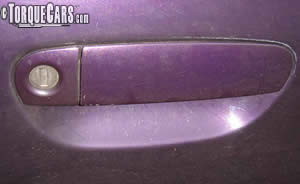Delocking - How to Delock a car
"Locking yourself out."
Delocking a car improves the appearance of a car and becomes a theft deterrent, no lock to pick means that often the criminal will move on to another vehicle. It will now be possible to be locked out of your car - no remote and no lock to pick means the only way into the car is through a window and in cars which have a deadlock mechanism you will physically have to climb in through the window as well.
Overview of work required,
Remove barrel
Take of the door card to allow a view inside at the door mechanism, often it is simply a detach from lock mechanism, twist and pull out the barrel. If you are planning also to remove the door handles you will need to fit a heavy duty solenoid that can withstand bad weather, otherwise if it fails the only way into the car will be through the window. When you fit a new solenoid do so about a month before you do the finishing work and test them thoroughly to make sure they are working properly.
Weld in a backing plate
This is an important step and it is worth keying the surface before welding in place to ensure that the filler adheres correctly. The backing plate should be an inch wider than the original keyhole. You can also use galvanised wire or mesh behind the gap to be filled.

Filler then smooth
Build the filler up in layers, allow to dry fully between each application, leaving the filler slightly proud of the paint work. With a fine grade grit of paper and sanding block sand away the excess filler. Take your time here - cutting corners will leave a tell tale dent in the door where the lock used to be. Fibreglass is a good product for filling areas like this but there are many body fillers available, just be sure to let it properly dry to avoid stretching and sagging.

Alternative methods of filling a key hole.
There are many other methods of delocking a car and these include adding glass fibre, building this up and then smoothing off and we have seen Lead and other metals used with the hole welded up.
Re-spray
Apply a mask to the car and be prepared to spray almost the whole door to allow a good blend. Paint should be applied in layers and built up over time gradually and then finished with a very fine grit of wet wet and dry paper and a good cutting paste. See our "stone chip repair" article and plastic painting article for details on getting a good paint finish.


If the lock is in the plastic door handle which is often the case of many cars the method is similar although there is a very attractive shortcut. Rear doors or even passenger door handles do not have keyholes so getting a standard handle without the key hole will make the job a lot easier for you and leaves the lock mechanism largely untouched.
Upol is good stuff for blending in seams, just slap it on, leave it to really harden off and then sand it back.
To discuss styling options for your car in more detail please join us in our friendly forum.
Please Check out my YouTube channel, we're regularly adding new content...
PLEASE HELP: I NEED YOUR DONATIONS TO COVER THE COSTS OF RUNNING THIS SITE AND KEEP IT RUNNING. I do not charge you to access this website and it saves most TorqueCars readers $100's each year - but we are NON PROFIT and not even covering our costs. To keep us running PLEASE Donate here
If you liked this page please share it with your friends, drop a link to it in your favourite forum or use the bookmarking options to save it to your social media profile.
Feedback - What do You Think?
Please use our forums if you wish to ask a tuning question, and please note we do not sell parts or services, we are just an online magazine.
Help us improve, leave a suggestion or tip
Please watch this video and subscribe to my YouTube channel.

 Click to accept YouTube Cookies & Play.
Click to accept YouTube Cookies & Play.